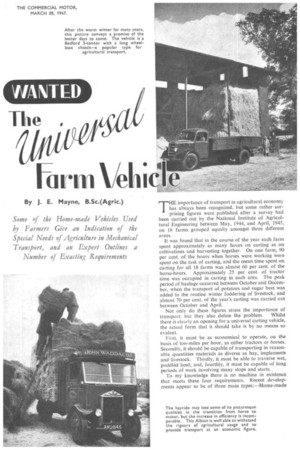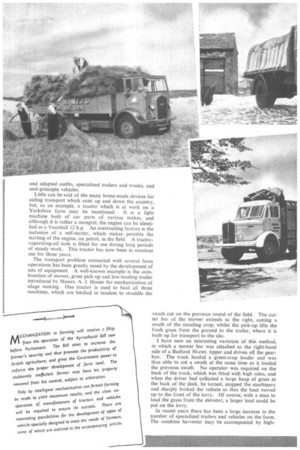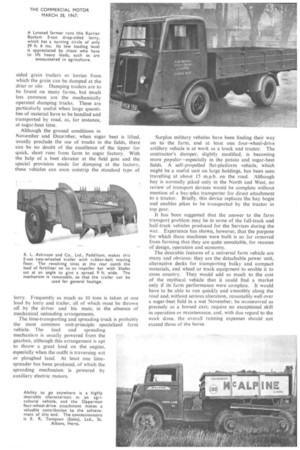The
Page 39

Page 40

Page 42

If you've noticed an error in this article please click here to report it so we can fix it.
krmVe By J. E. Mayne, B.Sc.(Agric.) Some of the Home-made Vehicles Used by Farmers Give an Indication of the Special Needs of Agriculture in Mechanical Transports and an Expert Outlines a
Number of Exacting Requirements
THE importance of transport in agricultural economy has always been recognized, but some rather sur
prising figures were published after a survey had been carried out by the National Institute of Agricultural Engineering between May, 1944, and April, 1945, on 18 farms grouped equally amongst three different areas.
It was found that in the course of the year each farm spent approximately as many hours on carting as on cultivations and harvesting together. On one farm, 90 per cent. of the hours when horses were working were spent on the task of carting, and the mean time spent on carting for all IS farms was almost 60 per cent. of the horse-hours. Approximately 25 per cent. of tractor time was occupied in carting in each area. The peak period of haulage occurred between October and December, when the transport of potatoes and sugar beet was added to the routine winter foddering of livestock, and almost 70 per cent. of the year's carting was carried out between October and April. Not only do these figures stress the importance of transport, but they also define the problem. Whilst there is clearly an opening for a universal carting vehicle, the actual form that it should take is by no means so evident.
First, it must be as economical to operate, on the basis of ton-miles per hour, as either tractors or horses. Secondly, it should be capable of transporting in reasonable quantities materials as diverse as hay, implements and livestock. Thirdly, it must be able to traverse wet, puddled land; and, fourthly, it must be capable of long periods of work involving many stops and starts. To my knowledge there is no machine in existence that meets these four requirements. Recent developments appear to be of three main types:—Home-made and adapted outfits, specialized traders and trucks, and unit-principle vehicles.
Little can be said of the many home-made devices for aiding transport which exist up and down the country, but, as an example, a tractor which is at work on a Yorkshire farm may be mentioned. It is a light machine built of car parts of various makes, and although it is rather a mongrel, the engine can be identified as a Vauxhall 12 h.p. An outstanding feature is the inclusion of a self-starter, which makes possible the starting of the engine, on petrol, in the field. A tractorvaporizing-oil tank is fitted for use during long periods of steady work. This tractor has now been in constant use for three years.
The transport problem connected with several farm operations has been greatly eased by the development of sets of equipment. A well-known example is the combination of mower, grass pick-up and low-loading trailer introduced by Messrs. A. J. Hosier for mechanization of silage making. One tractor is used to haul all three machines, which are hitched in tandem to straddle the swath cut on the previous round of the field. The cutter bar of the mower extends to the right, cutting a swath of the standing crop, whilst the pick-up lifts the fresh grass from the ground to the trailer, where it is built up for transport to the silo.
I have seen an interesting variation of this method, in which a mower bar was attached to the right-hand side of a Bedford 30-cwt. tipper and driven off the gearbox. The truck hauled a green-crop loader and was thus able to cut a swath at the same time as it loaded the previous swath. No operator was required on the back of the truck, which was fitted with high sides, and when the driver had collected a large heap of grass at the back of the deck, he turned, stopped the machinery and sharply braked the vehicle so that the load moved up to the front of the lorry. Of course, with a man to load the grass from the elevator, a larger load could be put on the lorry.
In recent years there has been a large increase in the number of specialized trailers and vehicles on the farm. The combine harvester may be accompanied by high sided grain trailers or lorries from which the grain can be dumped at the drier or silo. Dumping trailers are to be found on many farms, but much less common are the mechanically operated dumping trucks. These are particularly useful when large quantities of material have to be handled and transported by road, as, for instance, at sugar-beet time.
Although the ground conditions in November and December, when sugar beet is lifted, usually preclude the use of trucks in the fields, there can be no doubt of the excellence of the tipper for quick, short runs from farm to sugar factory. With the help of a beet elevator at the field gate and the special provision made for dumping at the factory, these vehicles can soon outstrip the standard type of lorry. Frequently as much as 10 tons is taken at one load by lorry and trailer, all of which must be thrown off by the driver and his mate, in the absence of mechanical unloading arrangements.
The lime-transporting and spreading truck is probably the most common unit-principle specialized farm vehicle. The feed and spreading mechanism is usually powered from the gearbox, although this arrangement is apt to throw a great load on the engine, especially when the outfit is traversing .vet or ploughed land. At least one limespreader has been produced, of which the spreading mechanism is powered by auxiliary electric motors.
Surplus military vehicles have been finding their way on to the farm, and at least one four-wheel-drive artillery vehicle is at work as a truck and tractor. The contractor's dumper, slightly modified, is becoming more popular—especially in the potato and sugar-beet fields. A self-propelled flat-platform vehicle, which might be a useful unit on large holdings, has been seen travelling at about 15 m.p.h. on the road. Although hay is normally piked only in the North and West, no review of transport devices would be complete without mention of a hay-pike transporter for direct attachment to a tractor. Briefly, this device replaces the hay bogie and enables pikes to be transported by the tractor in top gear.
It has been suggested that the answer to the farm transport problem may lie in some of the full-track and half-track vehicles produced for the Services during the war. Experience has shown, however, that the purpose for which these machines were built is so far removed from farming that they are quite unsuitable, for reasons of design, operation and economy.
The desirable features of a universal farm vehicle are many and obvious: they are the detachable power unit, alternative decks for transporting bulky and compact materials, and wheel or track equipment to enable it to cross country. They would add so much to the cost of the mythical vehicle that it could find a market only if its farm performance were complete. It would have to be able to run quickly and smoothly along the road and, without serious alteration, reasonably well over a suger-beet field in a wet November; be manceuvred as precisely as a horsed cart; require no exceptional skill in operation or maintenance, and, with due regard to the work done, the overall running expenses should not exceed those of the horse.
















































































